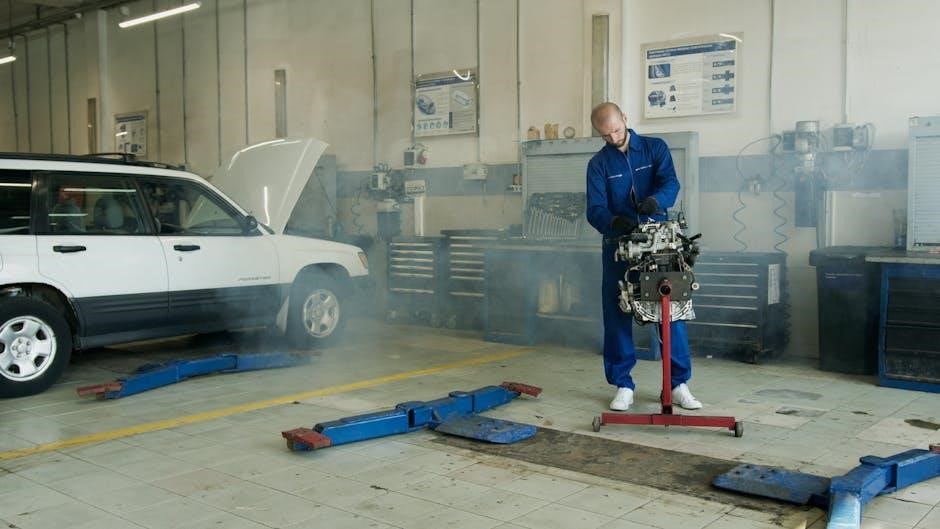how to check transmission fluid on a manual
How to Check Transmission Fluid on a Manual Transmission: A Comprehensive Guide
Maintaining your manual transmission is crucial for your vehicle’s longevity․ This comprehensive guide provides the necessary steps to check your manual transmission fluid, ensuring smooth operation and preventing costly repairs down the road․
Manual transmissions, unlike their automatic counterparts, require periodic fluid checks to ensure optimal performance․ Because they often lack a dipstick, checking the fluid involves a different process than many are accustomed to․ This introduction will guide you through the basics of manual transmission fluid checks, explaining why it’s important and what to expect․
Many modern manual transmissions lack a fluid level dipstick, requiring you to remove the fill plug to assess the fluid․ This method, while slightly more involved, allows you to directly observe the fluid level and condition․ Proper checks can help you know when to top off or change the fluid
Checking the fluid isn’t always necessary, but is important if you suspect an issue․ By understanding the process, you can ensure your manual transmission operates smoothly for years to come․
Why Checking Transmission Fluid is Important
Your vehicle’s manual transmission is a complex system of gears that relies on transmission fluid for lubrication and cooling․ Neglecting to check the fluid level can lead to serious and expensive problems․ Without adequate fluid, the gears can grind against each other, causing excessive wear and potential failure․ Regular checks can prevent this․
Checking the fluid allows you to identify potential issues early on․ Low fluid levels can indicate leaks, while discolored or contaminated fluid can signal internal damage․ Addressing these problems promptly can prevent further damage and extend the life of your transmission․ It also ensures smooth shifting and optimal performance․
Consulting your vehicle’s service schedule and regularly checking the fluid is a proactive step in maintaining your vehicle’s health․ By doing so, you’re safeguarding one of the most expensive components of your car․

Tools and Materials Needed
Before starting, gather the necessary tools and materials․ Having everything ready will make the process smoother and safer․ The right tools and fluid type are essential for accurate results․
Required Tools for the Job
To successfully check your manual transmission fluid, you will need a few essential tools․ First, acquire a socket wrench and the correct size socket to remove the fill plug, as the size varies by vehicle․ A drain pan is crucial to catch any spilled fluid, preventing a mess․
Consider a fluid transfer pump or syringe for adding fluid if needed․ A jack and jack stands are necessary to safely lift and secure your vehicle, providing adequate access to the transmission․ Don’t forget safety glasses and gloves to protect yourself from potential spills and contaminants․ A clean rag or shop towel will also come in handy for wiping away any excess fluid․ Finally, consult your vehicle’s manual for the specific tools recommended for your model․

Type of Transmission Fluid to Use
Choosing the correct transmission fluid is paramount for the health and performance of your manual transmission․ Using the wrong fluid can lead to damage, reduced efficiency, and premature wear․ Always consult your vehicle’s owner’s manual to determine the specific type of transmission fluid recommended by the manufacturer․

Manual transmissions typically require gear oil, which comes in various viscosities and specifications․ Common types include SAE 75W-90, 80W-90, or specific GL-4 or GL-5 rated oils․ Ensure the fluid you select meets or exceeds the manufacturer’s specifications․ Using a high-quality synthetic fluid can offer improved performance and protection, especially in extreme temperatures․ Never mix different types of transmission fluids, as this can lead to incompatibility issues․ When in doubt, consult a trusted mechanic for guidance on selecting the appropriate fluid for your vehicle․

Preparing Your Vehicle for Inspection
Before inspecting your manual transmission fluid, ensure your vehicle is properly prepared․ This involves taking essential safety precautions and securely lifting the vehicle for safe and easy access․
Safety Precautions Before Starting
Prioritizing safety is paramount before commencing any automotive maintenance․ Start by parking your vehicle on a level surface to prevent unexpected movement․ Engage the parking brake firmly to further secure the car, minimizing the risk of rolling․ Gather all necessary tools and materials beforehand to avoid interruptions and potential hazards during the process․
Allow the engine to cool down completely before beginning the inspection․ A hot engine can cause burns upon contact with metal surfaces․ Wear appropriate personal protective equipment (PPE), including safety glasses to shield your eyes from debris and gloves to protect your hands from chemicals and sharp edges․
Ensure adequate ventilation in your workspace, especially if working indoors, to avoid inhaling harmful fumes․ Keep a fire extinguisher nearby in case of emergencies․ Familiarize yourself with the locations of emergency exits and first aid supplies․ By adhering to these safety precautions, you can minimize risks and ensure a safe and successful manual transmission fluid check․
Lifting and Securing Your Vehicle

To access the transmission fill plug, safely lifting your vehicle is often necessary․ Begin by consulting your vehicle’s manual to identify the recommended jacking points․ These points are reinforced areas designed to withstand the weight of the vehicle without causing damage․
Position your hydraulic floor jack securely under one of the designated jacking points․ Slowly and steadily raise the vehicle to the desired height, ensuring it’s high enough to provide ample clearance for you to work comfortably underneath․ Never work under a vehicle supported only by a jack․
Once the vehicle is raised, immediately place jack stands under the frame rails or other designated support points near the jacking points․ Lower the vehicle onto the jack stands, ensuring they are firmly in place and bearing the weight of the car․ Give the vehicle a gentle shake to confirm its stability before proceeding with the inspection․ Repeat the process for the other side if needed, maintaining stability at all times; Safety is paramount during this step․

Locating the Fill Plug
Finding the fill plug is essential․ Manual transmissions typically lack a dipstick, so locating the fill plug is key to checking and adding fluid as needed for maintenance․
Identifying the Transmission Fill Plug Location
Locating the transmission fill plug is a critical first step․ Unlike automatic transmissions, most manual transmissions do not have a dipstick for checking fluid levels․ Instead, you’ll need to find the fill plug, which is typically located on the side of the transmission case․ This plug is usually a bolt or a recessed plug that can be removed with a wrench or socket․
The fill plug’s position can vary depending on the vehicle’s make and model․ Common locations include the driver’s side or passenger’s side of the transmission․ Look for a plug that is accessible and not obstructed by other components․ It is often near the middle of the transmission housing․
Visually inspect the transmission housing for any plugs that might fit the description․ The plug is usually the only access point for adding or checking the fluid level․
Consulting Your Vehicle’s Manual
Your vehicle’s manual is an invaluable resource for locating the transmission fill plug․ It provides detailed diagrams and specific instructions tailored to your car’s make and model․ The manual will pinpoint the exact location of the fill plug, saving you time and potential frustration․
The manual will also specify the type of transmission fluid your vehicle requires․ Using the wrong fluid can damage the transmission, so it’s crucial to adhere to the manufacturer’s recommendations․ Look for the section on “Maintenance” or “Fluid Specifications․”
In addition to the fill plug location and fluid type, the manual may provide information on the recommended fluid level and any specific procedures for checking or adding fluid․ Always refer to your vehicle’s manual for the most accurate and reliable information․

Checking the Fluid Level
With the fill plug located, the next step involves carefully removing it to access the transmission fluid․ Then, assess the fluid level to determine if topping off is necessary for optimal performance․
Removing the Fill Plug
Once you’ve located the fill plug on your manual transmission, the next step is to carefully remove it․ This usually requires a socket wrench of the appropriate size․ Ensure you have a good grip and apply steady pressure to avoid stripping the plug․
Sometimes, the plug can be quite tight, especially if it hasn’t been removed in a while․ If you encounter resistance, try using a penetrating oil to loosen it up․ Apply the oil around the plug and let it sit for a few minutes before attempting to remove it again․
Be cautious when removing the plug, as some fluid might seep out, especially if the transmission is overfilled․ Have a drain pan ready to catch any spills․ Once the plug is loose, you can fully unscrew it by hand․ Keep the plug in a safe place for reinstallation later․
Some manual transmissions feature a fill plug that requires a specific tool for removal․ Consult your vehicle’s manual to identify the correct tool, ensuring a smooth and damage-free removal process․
Determining the Correct Fluid Level
After removing the fill plug, you can now check the transmission fluid level․ With most manual transmissions, the correct fluid level is just below the fill plug opening․ You should be able to feel the fluid just beneath the hole․
If you can’t feel any fluid with your finger, or if it’s significantly lower, the fluid level is low and needs to be topped off․ Some people utilize a metal stem or small dipstick to verify the level precisely․
The fluid should be approximately 4mm from the bottom of the fill plug hole․ Inspect the fluid’s condition as well․ It should ideally be a reddish color․ Dark, burnt, or contaminated fluid indicates a need for a complete fluid change, potentially signaling internal transmission issues․
If you are unsure about the correct fluid level, consult your vehicle’s service manual for specific instructions․ Maintaining the proper fluid level is essential for the transmission’s health and performance․

Adding Transmission Fluid (If Necessary)
If the fluid level is low, adding the correct type of transmission fluid is essential․ Ensuring you use the right fluid and procedure will keep your transmission functioning optimally․
Choosing the Right Fluid
Selecting the correct transmission fluid is paramount for your manual transmission’s health and performance․ Using the wrong fluid can lead to poor lubrication, increased wear, and even transmission failure․ Always consult your vehicle’s owner’s manual to determine the specific type of fluid recommended by the manufacturer․
Manual transmissions typically require gear oil or a specialized manual transmission fluid, which differs significantly from automatic transmission fluid (ATF)․ ATF is generally not compatible with manual transmissions and can cause damage․ The owner’s manual will specify the exact fluid type, weight, and any applicable standards or certifications․
Double-check the fluid specifications before purchasing any fluid․ Look for labels that clearly state the fluid is suitable for manual transmissions and meets your vehicle’s requirements․ If you are unsure, consult a trusted mechanic or parts specialist for guidance to avoid costly mistakes and ensure optimal performance․
Adding Fluid Through the Fill Plug
Once you’ve determined that your manual transmission fluid level is low and have selected the correct fluid, carefully add fluid through the fill plug opening․ Use a fluid pump or a funnel with a flexible hose to direct the fluid into the transmission; Ensure the area around the fill plug is clean to prevent contaminants from entering the transmission․
Slowly add fluid, pausing periodically to allow it to settle and to avoid overfilling․ Since there is no dipstick in most manual transmissions, the fluid level is correct when it reaches the bottom of the fill plug hole․ When the fluid starts to trickle out, it indicates that the transmission is full;
Be cautious not to overfill, as this can cause leaks and other issues․ Once the fluid reaches the correct level, stop adding fluid and prepare to replace the fill plug securely․ Clean any spilled fluid from the transmission case to prevent dirt accumulation․

Final Steps and Considerations
After checking and, if necessary, adding transmission fluid, ensure the fill plug is securely replaced․ Regularly monitor your transmission for any signs of leaks or unusual noises, and consult a mechanic when needed․
Replacing the Fill Plug Securely
Once you have confirmed the correct fluid level in your manual transmission, the next crucial step involves replacing the fill plug securely․ This is essential to prevent leaks and maintain proper fluid pressure within the transmission system․ Begin by carefully cleaning the fill plug and the surrounding area of any dirt or debris․
Inspect the plug’s threads for damage and ensure the sealing washer (if equipped) is in good condition․ If the washer is worn or damaged, replace it with a new one to ensure a proper seal․ Apply a small amount of thread sealant to the plug’s threads to further prevent leaks․
Carefully thread the fill plug back into its opening, tightening it to the manufacturer’s specified torque․ Avoid over-tightening, as this can damage the threads or the transmission case․ Use a torque wrench to ensure accurate tightening․ After tightening, double-check the plug for any signs of leakage․ A securely replaced fill plug is vital for the long-term health of your manual transmission, preventing fluid loss and potential damage․
When to Consult a Mechanic
While checking and adding transmission fluid can be a task you undertake, certain situations warrant professional attention․ If you notice persistent leaks around the transmission, it’s crucial to consult a mechanic promptly․ Leaks can indicate damaged seals or other internal issues requiring expert repair․
Difficulty shifting gears, unusual noises during gear changes, or a slipping transmission are also red flags․ These symptoms may suggest internal damage or wear that needs diagnosis and repair by a qualified technician․ Additionally, if you are unsure about the correct type of transmission fluid for your vehicle or are uncomfortable performing the fluid check yourself, seeking professional assistance is advisable․
A mechanic can accurately assess the condition of your transmission, identify any underlying problems, and recommend appropriate solutions․ Ignoring these warning signs can lead to more extensive and costly repairs in the future, so timely intervention is key to maintaining the health of your manual transmission․